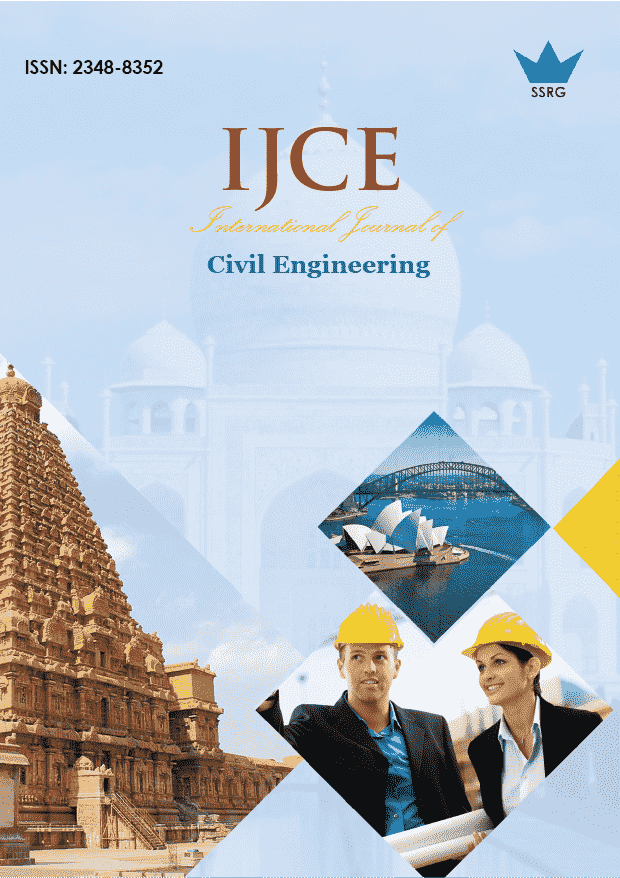Contribution of the Valorization of Needle Grass Residues Powder as a Coarse Aggregate in the Formulation of Ecofriendly Manufactured Precast Concrete

| International Journal of Civil Engineering |
| © 2024 by SSRG - IJCE Journal |
| Volume 11 Issue 12 |
| Year of Publication : 2024 |
| Authors : Mohammed Aqil, Halima Soussi, Maha Bentahar |
How to Cite?
Mohammed Aqil, Halima Soussi, Maha Bentahar, "Contribution of the Valorization of Needle Grass Residues Powder as a Coarse Aggregate in the Formulation of Ecofriendly Manufactured Precast Concrete," SSRG International Journal of Civil Engineering, vol. 11, no. 12, pp. 30-42, 2024. Crossref, https://doi.org/10.14445/23488352/IJCE-V11I12P103
Abstract:
The recovery of natural resources has become a major challenge; in recent years, many economic players have focused on reusing herb residues to formulate a new generation of innovative eco-friendly construction materials. In this study, the incorporation of Needle Grass Residue powder (NGP) derived from crushing herb that originates from the “stipa tenacissima Plant as a partial replacement for coarse aggregates in the precast concrete was explored to assess its economic, environmental, mechanical, and physical impacts. Various NGP replacement levels (0%, 10%, 25%, and 50%) were analyzed. Economic assessments showed a significant reduction in concrete production costs with increasing NGP content, indicating potential cost savings. Environmentally, NGP's addition contributed to substantial reductions in CO2 emissions and improved resource conservation, highlighting its potential for enhancing sustainability. Mechanical properties such as compressive and tensile strengths decreased with higher NGP percentages, suggesting a trade-off between cost and structural performance. Physically, the concrete mixtures with higher NGP content exhibited increased porosity and water absorption, affecting the durability. The results demonstrate that while NGP incorporation offers economic and environmental benefits, it also necessitates careful consideration of its impacts on precast concrete's mechanical and physical properties. This comprehensive analysis underscores the need for a balanced approach to optimize NGP usage in concrete for sustainable and functional construction applications.
Keywords:
Needle Grass Powder, Concrete, Sustainable construction, Agricultural residues, Aggregate replacement.
References:
[1] Nabilla Mohamad et al., “Environmental Impact of Cement Production and Solutions: A Review,” Materials Today: Proceedings, vol. 48, no. 4, pp. 741-746, 2022.
[CrossRef] [Google Scholar] [Publisher Link]
[2] C. Meyer, “The Greening of the Concrete Industry,” Cement and Concrete Composites, vol. 31, no. 8, pp. 601-605, 2009.
[CrossRef] [Google Scholar] [Publisher Link]
[3] Fernando Pacheco-Torgal, and Said Jalali, “Cementitious Building Materials Reinforced with Vegetable Fibres: A Review,” Construction and Building Materials, vol. 25, no. 2, pp. 575-581, 2011.
[CrossRef] [Google Scholar] [Publisher Link]
[4] Jing He, Satoru Kawasaki, and Varenyam Achal, “The Utilization of Agricultural Waste as Agro-Cement in Concrete: A Review,” Sustainability, vol. 12, no. 7, pp. 1-16, 2020.
[CrossRef] [Google Scholar] [Publisher Link]
[5] Aurélie Favier et al., “A Sustainable Future for the European Cement and Concrete Industry: Technology Assessment for Full Decarbonisation of the Industry by 2050,” ETH Zurich, pp. 1-93, 2018.
[CrossRef] [Google Scholar] [Publisher Link]
[6] Esmail Khalife et al., “Recent Advances in the Application of Agricultural Waste in Construction,” Applied Sciences, vol. 14, no. 6, pp. 1-18, 2024.
[CrossRef] [Google Scholar] [Publisher Link]
[7] Jun Zhao et al., “Exploring the Potential of Agricultural Waste as an Additive in Ultra-High-Performance Concrete for Sustainable Construction: A Comprehensive Review,” Reviews on Advanced Materials Science, vol. 63, no. 1, pp. 1-29, 2024.
[CrossRef] [Google Scholar] [Publisher Link]
[8] Z.P. Bazant, and S. Baweja, “Creep and Shrinkage Prediction Model for Analysis and Design of Concrete Structures-Model B3,” Symposium Paper, vol. 194, pp. 85-100, 2000.
[CrossRef] [Google Scholar] [Publisher Link]
[9] Wei Wang et al., “Agricultural and Aquaculture Wastes as Concrete Components: A Review,” Frontiers in Materials, vol. 8, pp. 1-20, 2021.
[CrossRef] [Google Scholar] [Publisher Link]
[10] Khondaker Sakil Ahmed, and Lutfar Rahman Rana, “Fresh and Hardened Properties of Concrete Containing Recycled Waste Glass: A Review,” Journal of Building Engineering, vol. 70, 2023.
[CrossRef] [Google Scholar] [Publisher Link]
[11] Hussein Kareem Sultan, Abbas Abdulhssein Abd Noor, and Ghasan Fahim Huseien, "Performance Evaluation of Self-Compacting Glass Fiber Concrete Incorporating Silica Fume at Elevated Temperatures,” Eng, vol. 5, no. 2, pp. 1043-1066, 2024.
[CrossRef] [Google Scholar] [Publisher Link]
[12] Marija Nedeljković et al., “Use of Fine Recycled Concrete Aggregates in Concrete: A Critical Review,” Journal of Building Engineering, vol. 38, pp. 1-27, 2021.
[CrossRef] [Google Scholar] [Publisher Link]
[13] Miquel Joseph et al., “Water Absorption Variability of Recycled Concrete Aggregates,” Magazine of Concrete Research, vol. 67, no. 11, pp. 592-597, 2015.
[CrossRef] [Google Scholar] [Publisher Link]
[14] G. Moriconi, “Recyclable Materials in Concrete Technology: Sustainability and Durability,” Sustainable Construction Materials and Technologies, Proceedings. Special Sessions of First International conferences on Sustainable Construction Materials and Technologies, Coventry, UK, pp. 1-12, 2007.
[Google Scholar] [Publisher Link]
[15] Julian Kirchherr, Denise Reike, and Marko Hekkert, “Conceptualizing the Circular Economy: An Analysis of 114 Definitions,” Resources, Conservation and Recycling, vol. 127, pp. 221-232, 2017.
[CrossRef] [Google Scholar] [Publisher Link]
[16] Rafat Siddique, Geert de Schutter, and Albert Noumowe, “Effect of Used-Foundry Sand on the Mechanical Properties of Concrete,” Construction and Building Materials, vol. 23, no. 2, pp. 976-980, 2009.
[CrossRef] [Google Scholar] [Publisher Link]
[17] Rafat Siddique, Waste Materials and By-Products in Concrete, 1st ed., Springer, pp. 1-416, 2008.
[CrossRef] [Google Scholar] [Publisher Link]
[18] F. Martirena, and J. Monzó, “Vegetable Ashes as Supplementary Cementitious Materials,” Cement and Concrete Research, vol. 114, pp. 57-64, 2018.
[CrossRef] [Google Scholar] [Publisher Link]
[19] Mohd Zulqar Nain, and Senthil Kasilingam, “Influence of Rice Husk Ash and Bagasse ash on Durability of Concrete,” Materials Today: Proceedings, vol. 93, no. 3, pp. 71-78, 2023.
[CrossRef] [Google Scholar] [Publisher Link]
[20] P. Mehta, and Paulo J.M. Monteiro, Concrete: Microstructure, Properties, and Materials, McGraw-Hill Education, pp. 1-659, 2006.
[Google Scholar] [Publisher Link]
[21] P. Jagadesh et al., “Examining the Influence of Recycled Aggregates on the Fresh and Mechanical Characteristics of High-Strength Concrete: A Comprehensive Review,” Sustainability, vol. 16, no. 20, pp. 1-35, 2024.
[CrossRef] [Google Scholar] [Publisher Link]
[22] Hussein Hamada et al., “Influence of Palm Oil Fuel Ash on the High Strength and Ultra-High Performance Concrete: A Comprehensive Review,” Engineering Science and Technology, an International Journal, vol. 45, pp. 1-10, 2023.
[CrossRef] [Google Scholar] [Publisher Link]
[23] R.R. El-Bessoumy, “Effect of Using Agricultural Wastes in Cement Blocks Production,” Al-Azhar Journal of Agricultural Engineering, vol. 3, pp. 7-16, 2022.
[CrossRef] [Google Scholar] [Publisher Link]
[24] M. Iqbal Malik et al., “Study of Concrete Involving Use of Waste Glass as Partial Replacement of Fine Aggregates,” IOSR Journal of Engineering (IOSRJEN), vol. 3, no. 7, pp. 8-13, 2013.
[Google Scholar] [Publisher Link]

 10.14445/23488352/IJCE-V11I12P103
10.14445/23488352/IJCE-V11I12P103